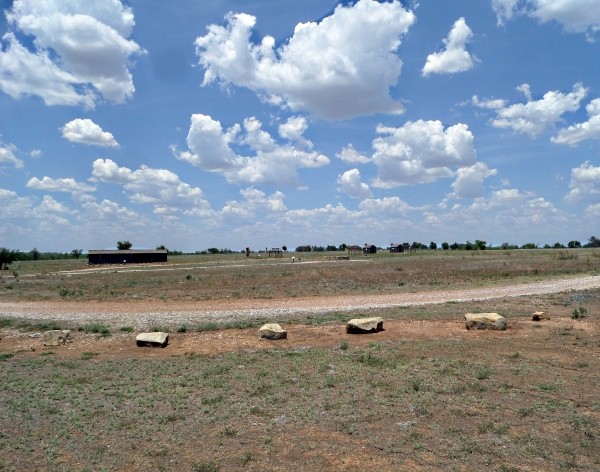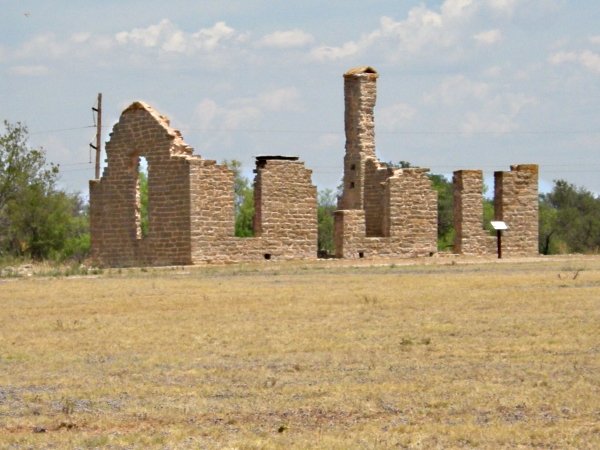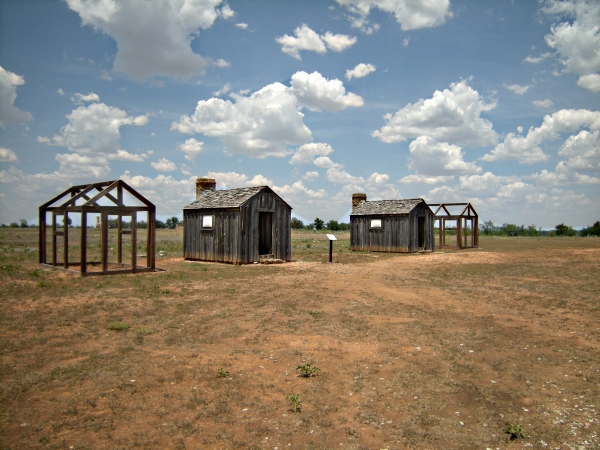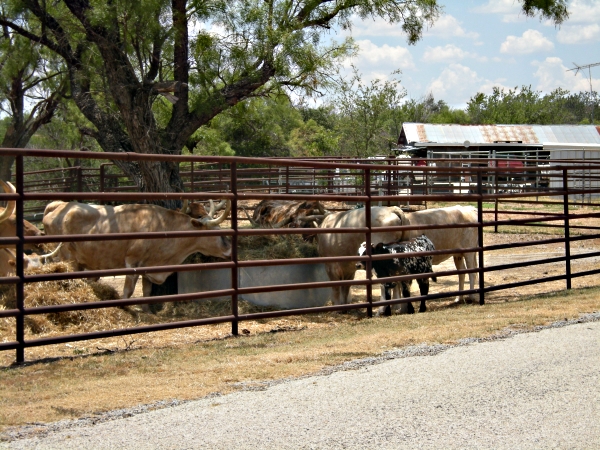Morning came on Saturday, as it is prone to do. We roused ourselves and got on the road a little after nine, running out of Amarillo to the east and south. M, for some reason or another, had taken a notion to see Fort Griffin so L planned the route to Austin around that.
The first place we got to was Claude, county seat of Armstrong County and possibly best known as the location for the filming of the movie Hud. Like most Panhandle communities, Claude is tiny; it musters just over a thousand people. The courthouse is boring and there’s nothing much to catch the eye but a grain elevator.
As we drove east and south, I was forcibly reminded just how much the Panhandle is Jeebus country. Worst was Clarendon, in Donley County, where there was a roadside sign or billboard every third block with a thumping Bible quotation, all identical in style and obviously the work of some militantly evangelical group. It was just the most overt of many signs, though, as crosses (not the highway-wreck memorial kind) were stuck up thick as trees in a forest along the road, in all the little towns. (One of the loneliest things in the world to be must be an atheist in a small town full of religion.)
Farther along we got to Quanah, named for the legendary Comanche chief. While it’s larger than most towns in the area, Quanah is also on the decline. Population peaked with the 1950 census; since then it has lost a third of its inhabitants. Probably its greatest clam to fame is being the origin of noted conservatives the Koch brothers, whose grandfather ran the local newspaper.
We stopped at the Sonic in Vernon for lunch, then turned south onto US 183 and 283, which ran southward to Seymour (and we didn’t “feed me, Seymour!”) and Throckmorton before 183 split off to go to Breckenridge, while we continued on 283 to the fort.


Well, such as it was. Abandoned in 1881, the permanent fort buildings were scavenged mercilessly for building stone, while the frame quarters were so poorly made, of green cottonwood planks, that they mostly fell down within a few years. The few frame structures now on the site are modern reconstructions meant to give examples of the kind of buildings that would have been there when the fort was in operation. Of the stone buildings, only the bakery, at the far end of the site, has been rebuilt; the two or three others that remain were left in ruins.

This foundation is all that is left of the post library, which also served as a chapel and a school at various times. Fort Griffin was considered to have a well-stocked library, with more than a hundred titles.

This row of huts housed the post’s first sergeants. Two to four unmarried men lived in each hut, or one married couple. (And you thought that being a military spouse is tough today? Try doing it in the middle of a howling wilderness!)

The hand-dug well for the post still exists, and was in use within living memory. The well is 45 feet deep, and has never been known to go dry. Yes, it looks nasty now—that’s what happens to wells that aren’t used and kept clean. You get algae blooms.

And what would a Texas travelogue be without some Longhorns? These are part of the official Texas herd of Longhorns, which lives at the fort and are used each year during the Fandangle, which we saw a couple of years ago. In honor of their O-fficial status, they’re all branded with a star on the left hip.
We didn’t stick around the fort very long. The temperature was over a hundred, and M and I were both wearing black. We retreated to the car, and drove back up the road a little piece to look at the site of the former town of Fort Griffin, which disappeared in the middle of the twentieth century. The property is in private hands now, but the owners don’t mind people coming to look as long as they don’t make a nuisance. They’ve even built some replica buildings representing businesses that were known to exist at the town.
It didn’t take us long to look at that particular horseshoe, so we drove on to Albany and picked up state highway 6 to Cisco, site of the Mobley Hotel, the first hotel ever owned by Conrad Hilton. The story goes that he came to Cisco intending to buy a bank, but changed his mind when he saw the Mobley renting rooms to oilfield workers eight hours at a time. (Cisco was swept up in one corner of the Ranger oil boom, and money flowed freely in the years immediately following World War I.) At Cisco we rejoined US 183, and followed it down through Rising Star, May, Brownwood, Zephyr, Mullin, Goldthwaite, and Lampasas and at last back home.
